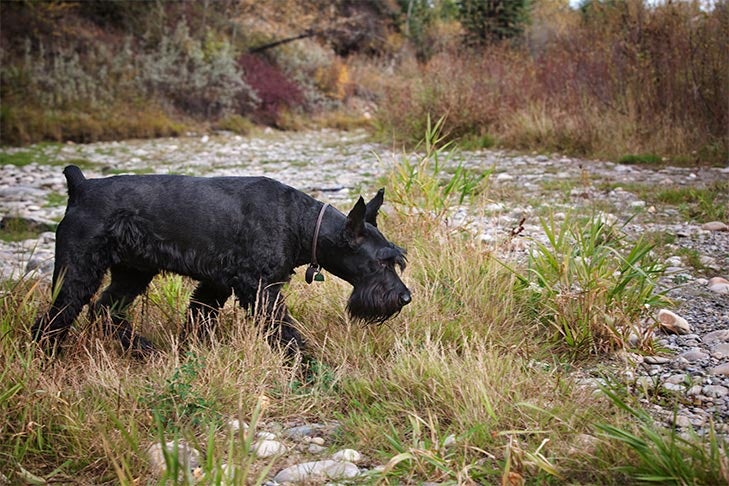
Every dog lover has heard a variation of the miraculous lost dog story. The pup who slipped her leash and beat her owners home. The dog who ran all the way home across town from the sitter’s place. The rascal who disappeared into thin air, then showed up two weeks later with a stench, an appetite, and a wag of the tail.
But how exactly do lost dogs find their way home from so far afield?
New research from the Czech Republic might hold the answer.
Dogs Navigate Using Magnetic Fields
Researchers equipped 27 dogs from 10 breeds with cameras and GPS collars, then monitored a combined total of 622 trials in forests in the Czech Republic. For the experiment, dogs walked through the forest with their owners, off-leash, until they scented their prey. When they departed to catch the prey, the owner remained in place. The team then studied the dogs’ return journeys to their owners—and it might be no surprise to learn that many dogs used their powerful noses to navigate, with almost 60 percent of them following their outbound route by tracing their own scent.
But in a full one-third of cases, dogs did something else. At the beginning of their homebound journey, they ran for about 20 meters (65 feet) along the north-south axis, whether or not their owner was located north or south of them. They then ran back on an entirely new route.
Given the unifying north-south orientation of these runs, researchers extrapolate that these initial “compass runs” helped dogs orient themselves. Even more fascinating: the dogs that did compass runs completed the trial significantly faster than dogs who returned home on the outbound route using scent tracking.
In short: dogs’ incredible ability to find their way home seems to spring from an ability to detect magnetic fields.
What Can We Learn From Dogs’ Magnetic Homing Superpowers?
The researchers stress that more research is needed to understand exactly how dogs use their ability to perceive magnetic cues. But they also point out that dogs are not alone in this ability. “It has been well established that a broad array of organisms have a ‘magnetic sense,’ ie. magnetoreception, which is used for spatial orientation and navigation,” researcher Kateřina Benediktová says. “Pigeons and migratory birds [are especially well studied] … as well as sea turtles, amphibians, and insects.” Benediktová adds that while magnetic-based navigation has been studied in some wild mammals—such as whales, bison, caribou, and zebras—on the whole, dogs remain underrepresented in the field.

It’s worth asking why humans might have been slow to appreciate this aspect of dogs’ behavior. Could it be that we struggle to recognize that our beloved dogs have capacities dating back to their lives before domestication? That in some ways, they are still built for lives in the wild, very different to those they typically lead today?
Benediktová speculates that all dog breeds likely have the power to receive magnetic information—but that the sense is simply dormant in pet dogs. She urges dog lovers to recognize this and other facets of dogs’ unique dogness. “I would like to say something about dogs in general,” she says. “They are really extraordinary animals, and we should care about them, protect them, and love them. But the dog must be still the dog, with its own character, behavior, and appearance. We should not try to change dogs to human.”
Homeward Bound: The Most Remarkable Stories of Dogs’ Homing Abilities
The research might be new, but dogs’ homing abilities have been celebrated throughout the ages. Here are some of our favorite stories of dogs navigating their way through thick and thin.
During World War I, Airedale Terriers, Border Collies, Old English Sheepdogs, Retrievers, and mixed breeds were used as messengers, relaying messages between battle headquarters and the trenches on the Western Front. Their service was irreplaceable, since they could be relied upon to navigate large areas of terrain and to cover ground where vehicles might get caught in mud and humans might be attacked by the enemy. One particularly valiant messenger dog was an Airedale Terrier named Jack, who ran through enemy fire for half a mile, carrying a message to headquarters that the troops on the front line needed reinforcements. His bravery saved many lives that day.
Then there’s the story of Bucky, a three-year-old Labrador who, in 2012, traveled 500 miles from Virginia to South Carolina in search of his owner, Mark Wessells. Wessells had delivered Bucky to live with his father in Virginia, because his accommodation banned dogs. Eight months later, Bucky showed up, wandering a forest in South Carolina. A local man took him in, fed him, and took him to the vet, who read his microchip and discovered that he belonged to Wessells. The reunion between man and Labrador was joyful—but only Bucky will ever know the full story of his 500-mile journey.
And finally, a tale of the strength of puppy love. In Terre Haute, Indiana, a pair of stray dogs named Ben and Jade were taken into a shelter when Jade became pregnant with a litter. The dogs remained together in the shelter for several months, until Ben was rescued. Just three weeks later, he bolted from his new home and crossed 10 miles of streets, railroad tracks, and other obstacles to find Jade at the shelter. Seeing the strength of the reunited pair’s bond, Ben’s new family decided to rescue Jade, too.
It just goes to show that dogs’ magnetic charm is way more than skin deep.

